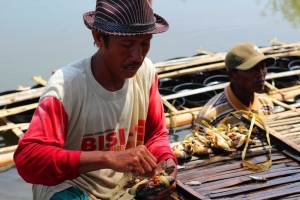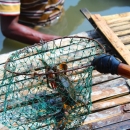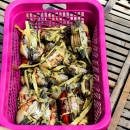Mangrove crab: Ecologically significant and economically promising
Location: Tanjung Pecinan Village, Mangaran, Situbondo, East Java, Indonesia. 20th Mar 2017
Since 2000, Situbondo’s mangrove coverage has been reduced significantly, largely due to large-scale conversion of mangrove forests into shrimp ponds and for milkfish aquaculture along the coast of Mangaran, a sub-district in Situbondo. This conversion, and the absence of a coastal green belt, have led to coastal erosion and a loss of around 50-100 m of land. Many fishponds have been destroyed by the coastal erosion, resulting in the loss of livelihoods for some communities.
To strengthen the resilience of ecosystem-dependent coastal communities, the socio-economic development of the communities living near the mangrove ecosystem is equally as important as the mangrove rehabilitation itself. A project in Tanjung Pecinan village, Mangaran, Situbondo, implemented by Samir Bamboo Conservation (SAMBACO) under a Mangroves for the Future (MFF) grant, aims to protect mangroves against sea abrasion through mangrove rehabilitation and livelihood development activities in Mangaran.
Crab fattening was identified as an alternative livelihood that could increase the income of communities in Tanjung Pecinan village. In crab fattening, wild-caught juvenile crabs weighing about 100-150 grams are put in floating bamboo cages that are 1m by 1.5 m in size. Every cage fits up to 40-50 crabs. The crabs are fed two times a day, in the morning and evening, for 20 days. After 20 days, the crabs weigh 200-250 grams and are ready to be harvested by community groups.
Due to the high market value of crabs, some local communities catch and sell crabs to earn additional income. In the mornings, they work as farmworkers, or are porters at places for fish auctioning and at night they search for crabs.
When SAMBACO started the crab fattening initiative, the villagers were very enthusiastic and subsequently formed a farmers' group. Theoretically, crab fattening is not that easy and the risk is quite high, but the production period is relatively short.
“It was almost impossible at first. However, through hard work, perseverance and learning crab characteristics inside the cage, we finally achieved a good result. Even though some juvenile crabs died during the process, we could still derive benefits from crab fattening thanks to the high market value of the crabs,” said Sumarwan, a crab middleman in Tanjung Pecinan village.
As a middleman, Sumarwan helps the farmer groups market and sell fattened crabs to bigger middlemen. Before Sumarwan joined the group, he facilitated the marketing of crabs by selling them to bigger middlemen or directly to consumers. He buys crabs from the villagers at a price ranging from IDR 40,000 to IDR 55,000 per kg., depending on the size. “I buy crabs from villagers and pay them directly, in order to help them market their products. Then I sell the crabs to the bigger middlemen or directly to consumers, where I sometimes receive installment payment,” Sumarwan explained. After he joined the crab-fattening activity, he helped group members to sell the crabs to his network, bigger middlemen and direct consumers at a higher price.

Sunail harvesting crabs and packing them in a "tail-down" position with their arms and legs folded inward toward their bodies to be sold live © Cynthia Nurcahya
35-year-old Sunail is a mud crab fisher. On a daily basis, he works with a boat owner to catch fish and at night, he catches crabs by using nets near fish pond dykes. If he’s lucky, he catches around 5 – 20 crabs per night.
The next morning, he sells the crabs to middlemen who then sell the crabs to markets in Situbondo and Probolinggo. Since Sunail was introduced to the crab fattening activity, he has been able to sell his bigger crabs at a higher price. The crabs can be sold for around IDR 100,000 – IDR 150,000 per kg. After being introduced to the crab fattening activity, Sunail now earns approximately IDR 4,500,000 -- 7,500,000 on average per month, 230% more than what he used to earn before. He has also been able to earn extra income from making the bamboo crab cages. He occasionally receives orders from the community to build floating cages with a price of IDR 1,500,000 for total work contracted.

Harvesting mangrove crabs © Cynthia Nurcahya
From the crab fattening, local people have an alternative way to improve the marketability of the crabs they catch. From this activity, they can grow the crabs until they reach 250 -- 300g. in size. The crab price at that size is significantly higher, around IDR 100,000 – IDR 150,000 per kg. In the initial production stage, the net profit the group made was IDR 1,000,000 per month (with two production cycles). With hard work and perseverance, taking up crab culture or fattening in an eco-friendly way can raise the economic status of coastal communities.
The participatory approach to improving and strengthening community resilience, which is central to the MFF resilience framework, has proved that effective and sustainable ecosystem management solutions must engage individuals and communities.

Mangrove crabs packed in a "tail-down" position with their arms and legs folded inward toward their bodies to be sold live © Cynthia Nurcahya


